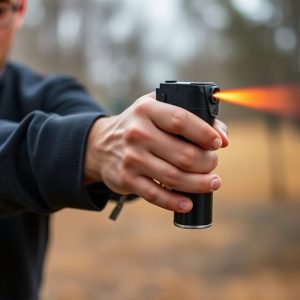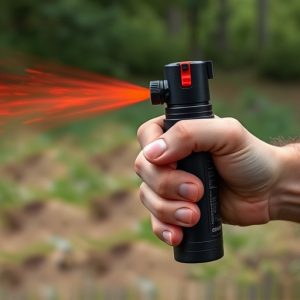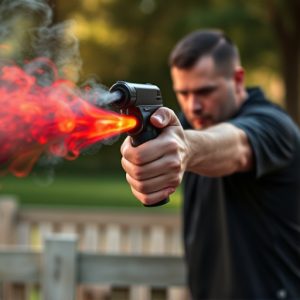Capsaicin Spray: Unlocking Effective Self-Defense Techniques
Capsaicin, the active ingredient in chili peppers, is a powerful natural compound used in effective…….
Capsaicin, the active ingredient in chili peppers, is a powerful natural compound used in effective pepper spray self-defense techniques. By disrupting cell membranes and triggering nerve endings, capsaicin creates an intense burning sensation that can temporarily disable aggressors. Strategic deployment of pepper spray, aiming at sensitive areas and using quick, short bursts, provides crucial time for escape and help-seeking. Regular training and understanding legal considerations are vital for responsible use and personal safety.
“Uncover the power of capsicum as a self-defense deterrent in this comprehensive guide. Capsaicin inflammatory agent spray, derived from chili peppers, offers a unique non-lethal option for personal safety. Explore ‘Understanding Capsaicin’ to delve into the science behind its effectiveness. Discover the numerous benefits of pepper spray for self-defense and learn the best techniques to deploy it successfully. Additionally, we’ll navigate legal considerations and essential safety precautions, ensuring you’re prepared with the knowledge of the best pepper spray self-defense techniques.”
- Understanding Capsaicin: The Science Behind the Spray
- Benefits of Using Pepper Spray for Self-Defense
- Effective Techniques for Deploying Capsaicin Spray
- Legal Considerations and Safety Precautions
Understanding Capsaicin: The Science Behind the Spray
Capsaicin, the active ingredient in chili peppers, is a powerful natural compound that serves as the basis for many self-defense sprays. When incorporated into defense techniques, capsaicin creates an effective deterrent by exploiting our body’s response to pain. The spray triggers a burning sensation and inflammation, temporarily disabling an aggressor. This understanding of capsaicin’s science behind it makes it a popular choice among individuals seeking the best pepper spray self-defense techniques.
By utilizing this compound, users can create a safe distance from potential threats, providing crucial time to escape or call for help. The inflammatory agent works by disrupting cell membranes and triggering nerve endings, causing an intense irritation that can last for several minutes. This temporary but powerful effect has made capsaicin-based sprays a go-to option for personal safety, offering individuals yet another tool in their self-defense arsenal.
Benefits of Using Pepper Spray for Self-Defense
Using pepper spray as a self-defense mechanism offers several significant advantages in potentially dangerous situations. As one of the most effective non-lethal options available, it can provide individuals with a powerful tool to deter and disable attackers. The key active ingredient, capsaicin, is extracted from chili peppers and is known for its ability to cause temporary yet intense irritation when in contact with skin or eyes, significantly impairing an assailant’s mobility and vision.
When deployed correctly, pepper spray can give users valuable time to escape and seek help. It is widely recognized as a game-changer in personal safety, especially in scenarios where physical strength might not be equal between the defender and aggressor. The best pepper spray self-defense techniques emphasize aiming for vulnerable areas like the face and eyes, using it in short bursts to maximize its effectiveness while minimizing exposure to the irritant.
Effective Techniques for Deploying Capsaicin Spray
When deploying capsicim inflammatory agent deterrent spray, or pepper spray, as a self-defense mechanism, understanding effective techniques is crucial. The best pepper spray self-defense techniques involve aiming for sensitive areas like eyes, nose, and mouth to maximize its impact and disrupt an attacker’s ability to continue the assault. Holding the can at close range, around 2–3 feet (0.61–0.91 m), allows for a more precise and effective blast, ensuring the spray reaches its target directly.
For optimal results, use quick, short bursts rather than prolonged sprays. This technique helps conserve the spray’s potency and increases the likelihood of disorienting or deterring an attacker. Additionally, practice good body positioning, using barriers like walls to contain the spray’s spread and protect bystanders. Regular training in these best pepper spray self-defense techniques can significantly enhance personal safety and ensure the spray is used effectively when needed.
Legal Considerations and Safety Precautions
When considering the best pepper spray self-defense techniques, it’s crucial to understand the legal considerations and safety precautions surrounding its use. Each jurisdiction has specific laws regarding the carrying and use of pepper spray for self-defense. Before purchasing or using any type of pepper spray, individuals should familiarize themselves with local legislation to ensure compliance and avoid potential legal repercussions.
Safety precautions are paramount when handling pepper spray. It’s essential to follow manufacturer instructions diligently, including proper storage and disposal methods. Users must also be aware of the range and effectiveness of the spray, typically around 2-3 meters, and understand that it can cause temporary blindness, coughing, and difficulty breathing. Training in proper application techniques is highly recommended to maximize its deterrent effect and minimize potential harm to oneself or bystanders.
Capsaicin inflammatory agent deterrent spray, with its proven effectiveness in self-defense, offers a powerful tool for personal safety. By understanding the science behind it and mastering the best pepper spray self-defense techniques, individuals can protect themselves in various scenarios. However, legal considerations and safety precautions must be paramount when carrying such a device. Following the guidelines outlined in this article will ensure responsible use, helping to keep you and your loved ones safe.


